Species
Species you can hunt in South Africa as a trophy hunter
Please note
- This is a list of game species you can encounter on your Southern Africa Safari,
not all of these species are hunt-able in South Africa, legislation and CITES prohibits the hunting and export of certain of these species.
For a list of trophy species we offer please refer to our Price list.
Aardwolf
(Latin = Proteles cristatus, Afrikaans = Aardwolf, German = Erdwolf)
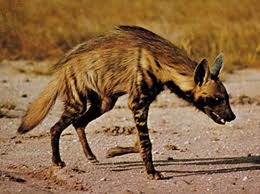
Numbers: Fairly high.
Weight >
8 - 10
kg;
18 - 22 lb.
Shoulder
height>
50 cm;
20 in.
Pregnancy time:
58-62
days.
Pup quantity:
Up to 4.
Found everywhere in South Africa, except in the most northern coastal area of
the Atlantic Ocean (in the North Cape Province) and in some part of Garden route, which covers a fair amount of the coastal area where the Western and Eastern Cape Provinces meet.
The aardwolf shouldn’t be considered as a carnivore in any strict sense : it actually feeds on millions of termites or harvesters. It’s size and name have made many famers decide
that his diet could include sheep and goats, which have proved to be an unfair expectation. The aardwolf’s dental framework isn’t the typical strong arrangement of the meat-eating family. At night the would
come out of their underground hideouts, and wander about in a small group (or sometimes alone). They would – somewhat clumsy - steer away from trouble and confrontations with other fighting animals, but if
confronted, their defence would, if the dodging runaway plan didn’t work, first consist of a raising of its back manes, growl and bark fearsome as if it is much more dangerous than it really is. And if that
doesn’t do the trick, secreting a strong musk-like scent will be the next move, which can makes their enemies hesitate and gives the aardwolf the necessary time to make it to the nearest bunker “down under”.
African Buffalo
(Latin = Syncerus caffer, Afrikaans = Afrikaanse buffel, German = Afrikanisher Büffel)
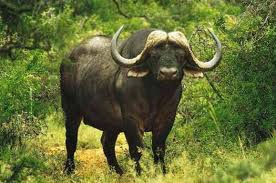
Numbers: Fairly high
Weight >
Up to 800 kg
1760
lb.
Shoulder
height>
140
cm
56 in.
Pregnancy time:
330 - 346 days
Calf quantity:
1
Found along the warmer Bushveld and Lowveld areas, especially the northern and eastern borderlines of the Northern Province and Mpumalanga, as well as in the northeastern KwaZulu-Natal
area and in a game park in the Eastern Province.
Together with the lion, the leopard, and maybe the elephant, the buffalo competes as one of the most dangerous of all animals to hunt. Most people might even say that it is
THE MOST DANGEROUS! For if it isn’t shot dead with the first shot, you need a very, very experienced hunter and solid sharpshooting at your side. If that’s not available, don’t even start the hunt.
The buffalo knows how to turn the table on a hunter: you may be too slow and too late to realize that you are the hunted! When wounded, it will “dissapear” among the hundreds of other buffalos of
the herd, or take a well covered hide-out. Over the years, many of those pursuing hunters have had a sudden breaking of branches as their final sounds ever heard. They will not stop except
if the final shot is, let alone in time and from the necessary calibre, but dead centre into the brain itself. The buffalo might even have its revenge hours and hours after the first shot. The gore from
a buffalo is almost always fatal. The buffalo loves water and grasslands. Their horns may grow over 140 cm (over 50 in.) Although it did happen in the past, a single lion will have a battle royal if it
decides to take on a full grown buffalo on its own.
African Civet
(Latin = Civettictis civetta, Afrikaans = Afrikaanse siwet, German = Zibetkatze)
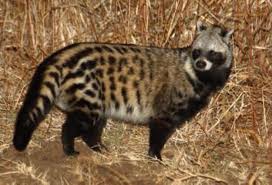
Numbers: Low
Weight >
9 - 13
kg
18 –31
lb.
Shoulder
height>
40 cm
16 in.
Pregnancy time : 57 - 63 days
Cub/Pup quantity: Up to 4
Found in the warmer northern area (Bushveld) of the North West and Northern Province, just as in the most of Mpumalanga, across East Swaziland and in the northern areas of KwaZulu-Natal.
The German name can be misleading, for it’s not really a cat. While it might be the nearest thing to a “cat-dog” hybrid, the civet is a carnivore, eating birds and small mammals, but also
enjoys a somewhat broader menu of insects, amphibians, reptiles and fruit. It stems from the mongoose family. This is a night animal and seldom seen, a stealthy character which some regular tourists may
never seen. Although its legs are long, it mostly has an arching back and low head when it moves it’s rather heavy body. When the civet is disturbed, it will give a distinct smell, and its glands near the
anal channel also yields a musk-like “perfume”. The civet is, in any case, a brave fighter.
African Elephant
(Latin = Loxodonta africana, Afrikaans = Afrikaanse olifant, German = Afrikanischer Elefant)
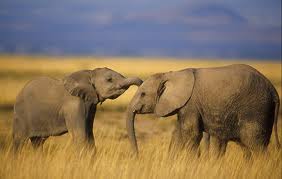
Numbers: Fairly high
Weight = Up to 6570kg; 14 454lb.
Shoulder height = 4 meters; 160 in.
Pregnancy time = 660 days
Calf quantity = Up to 2, mostly 1
Found in the Kruger National Park (and surrounding Parks), in the most northeastern area of the Northern Province, in the most northeastern area of KwaZulu-Natal, in the Eastern Province
only in the Addo Elephant Park, and in some areas of the Bushveld in the Northern Province which reintroduced them late in the twentieth century. Elephants became extinct in the Knysna eara of the Western
Cape at the end of the last century/millennium.
What a wonderful, truly majestic and fascinating animal this is!
Although the elephant’s extraordinary place in the African wildlife is guaranteed due to its massive size alone, it have such a special and unique way of living, that any tourist may be treated on a elephant
safari alone, without tiring for weeks. The elephant is in a class of its own: highly intelligent, very social, much supportive towards one another and by nature in a habit of taking care of their weak ones
and their small calves in a way that isn’t seen in other mammals. Elephants that have run into difficulty may lean on the others, often in the most literal sense of leaning on the support of their bodies or
tusks. If large numbers of lions threaten them, the biggest ones would form a line of defense around the smaller ones. An elephant’s cushioned feet helps it to move in almost dead silence. This massive animal
can pull down a big tree by mere force and can eat up to 300 kg (660lbs) leaves and plants and drink up to 315 litres (70 gallons) of water a day. A big bull can move all 6- 7 tons of its weight at speeds of
almost 40 kilometers an hour (24 miles/h). By only one suck of its trunk about 17 liters (3,8 gallons) of water becomes available to him. Tusks of over 450 lbs a pair was recorded!
And the elephant may roam the wild bushes for up to 70 years – that is, if it can outwit the ivory hunters for all these decades - before the legendary elephant graveyard is visited and this greatest of all
land mammals lay down its awesome head.
Antbear
(Latin = Orycteropus afer, Afrikaans = Erdvark, German = Erdferkel)
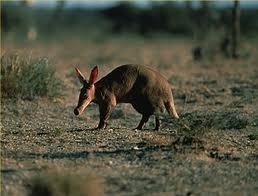
Numbers: Fairly high.
Weight = 41 - 65 kg ; 90 - 143 lb.
Shoulder height = 60 - 75 cm; 24 - 28 in.
Pregnancy days = 210
Found all over South Africa, with the exception of the Western Cape’s Peninsula and a small part of the Garden Route, the coastal area where the Western and Eastern Cape meets, as well as
the most northern coastal area of the North Cape.
Here’s the fellow whose extinction will change the face of the South African wildlife dramatically! Luckily, it doesn’t seem to be a serious possibility. But so many of the smaller animals
are using this guy’s digging for their own advantage. Of course, there’s disadvantages to a great amount of antbear holes in a farm or gamepark (go ask a long list of horsemen or offroad motorcyclists!)
The amount of burrows dug by the antbears of this country is absolutely uncountable. This powerful digger have surprised many tourists when, usually on night safari’s they encountered the
antbear: one wonders how it can be so unknown and yet so big. It uses its well developed claws to dig powerfully into the savanna sandlands and often wanders of after a while to dig another. This opens the
way for many a small family of other species to find a well-prepaired home or hideout to breed. It sometimes balances itself on its tail in an upright sitting position. It feeds on millions of small ants or
termites, collecting them with its very long tongue which seems to glue the ants to it by a thick type of saliva. For this fellow to disappear in a burrow, starting afresh, will take only a
few seconds. The soil is worked out by solids kicks from the back feet. This also serves as an safety device against would-be followers “down under”.
Bat-eared Fox
(Latin = Otocyon megalotis, Afrikaans = Bakoorvos/Draaijakkals, German = Löffelhund)
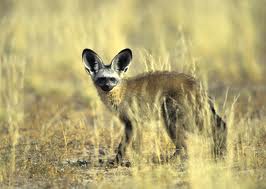
Numbers: Fairly high
Weight = 3 - 5kg; 6 - 11 lb.
Shoulder height = 30 cm; 12 in.
Pregnancy time = 60 days.
Pup quantity = 4 - 6
Found everywhere in South Africa’s central and western parts (including the western half of the Free State), but avoids most mountainous and all coastal areas.
It is found nowhere in any of the eastern parts, but is found all along the Northern Province’s northern borderlines.
This little fox isn’t in the cattle raging business. It feeds on termites, locusts, beetles, bird’s eggs and other insects, small reptiles or wild fruits. It doesn’t have teeth like the
carnivores and was often, for this reason, captured when small, to serve as pets.
Of course, their ears are its main sense of survival and it is said that it can distinguish between different sounds of underground termites!
It loves to walk and work in small groups. It also falls prey to skin hunters for their soft furry skins. It has often survived a skin hunt by doubling back to
its own spoor (all at great speed) and thus confusing the hunters and their dogs, earning him the title as the “turnback fox” in Afrikaans (eg. The “Draaijakkals”).
Black Rhinoceros
(Latin = Diceros bicornis, Afrikaans = Swartrenoster, German = Schwarzes nashorn)
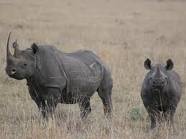
Numbers: Very low.
Weight = Up to 1000kg; 2200lb.
Shoulder height = 160 cm; 64 in.
Pregnancy time = 450 days
Calf quantity = 1
Found only in the southern Kruger National Park, at two game parks in the northeastern area of KwaZulu-Natal, in an Eastern Province game park, and in a game park of the North
West Province.
Don’t mess with this guy. His temper and nerve let it seem as if he has slept in the thorn bushes last night. While his nephew, the white rhino, has a square mouth (and is bigger in size),
the black rhino has a round mouth (or a “hook lip”). This rhino’s eyesight is as bad as his temper – he is short sighted, but his rounded, receptive ears and good smell seems to fill in what might be lacking
in sight. The black rhino may seem quite timid and slow, but, if provoked, his ill-temperedness will quickly show: seconds later he might leave behind a new way of broken bush in his dangerous
charge, ended in fierce snorting as if to say his ready for more action. His motto seems to be “first fight, then ask questions”. Tourist are well advised to keep the distance. The black rhino’s
horn can reach almost 50 inches.
Black Wildebeest
(Latin = Connochaetus gnou, Afrikaans = Swartwildebees, German = Weissschwanzgnu)
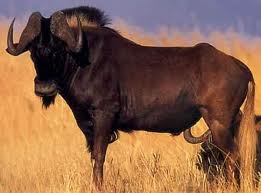
Numbers: Fairly low.
Weight = 60 - 160kg; 198 - 352 lb.
Shoulder height = 120 cm; 48in.
Record Horn Length: SCI = ? in; Rowland Ward = 29 and three eights in.
Females horns? Yes
Found mainly in the Free State, overflowing only a little bit to the west and north of the Free State.
Here we have the natural joker of the South African animal scene! Pretty of sheer ugliness, this horse-cum-bull-cum-athlete of the fields just can’t be content with a lazy African scene.
Either their heads have to be going up and down, up and down, or their bodies have to be circled around and around, while whirling their long, hairy tails to and fro or their hooves have to be kicking
wayward all the time. If that’s not enough helping to fade away the energy, running at top speed in wide, wide circles, as if in pursuit of something (or flying from something) is the way to
go for the black wildebeest, just to return and starting the jokerlike behaviour all over again. Their racing reminds of a horserace scene with corresponding tails in the wind and
bundling together at maximum speed ; which, incidentally, may even exceed that of the Old Turf Club’s betting arena. Just as much, a black wildebeest, jokingly playful most of the time, may suddenly be
ignited in fury. Then it’s a bullish beast that may run havoc in the tribe, killing young ones without any discrimination, or ostriches, horses and, of course people (if they would dare to be in the way).
Found only in South Africa, it became almost extinct in the nineteenth century, but saved in the twentieth, thanks to concerned farmers and conservationists jointly.
Black-backed Jackal
(Latin = Canis mesomelas, Afrikaans = Rooijakkals, German = Schabbrackens Chakal)
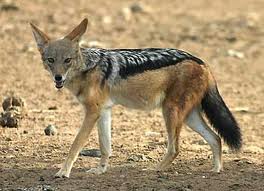
Numbers: Very high.
Weight = 5 - 10kg; 11 - 22 lb.
Shoulder height = 38 cm; 15 in.
Pregnancy time = 60 – 70 days
Pup quantity = 1- 8
Found all over South Africa, with the exception of the Western Cape’s Peninsula and a small part of the Garden Route, which is the coastal area where the Western and Eastern Cape meets
This best-known of all the foxes of South Africa is maybe the most hunted of all species in the country. And yet, its numbers haven’t reflect negatively on this cat and mouse play which
farmers and hunters have tried on this ingeniously witty little creature. Being a “disturbing problem” to sheep and small cattle farmers all over the country, declared a “pest” and being at the receiving
end of may an animal control officer’s endeavour, it has escaped the bulk of all the traps, hunting dogs, poison and shots that was meant to be the black-backed jackal’s end. It is a well known character
in many a South African tale where the trumps up jackal will very seldom be found at the soaring end after the punchline was given. The daytimes isn’t used for his mischievous activities,
except in very undisturbed fields. It feeds on small mammals – and yes, they do eat lamb! They also enjoys dead and putrefying flesh (sometimes the left-overs after the lion and hyena have both had their share).
In the vulture/jackal combat, he regularly steals from a vulture. It is even recorded that in a very competitive dual with a vulture, the jackal opted to have the vulture itself! The hungry jackal won’t
ignore birds, reptiles, insects, or fruit. The jackal family sticks together and both the father and last years pups may assist the mother with this years puppy-raising drills.
Blesbok
(Latin = Damaliscus dorcas phillipsi, Afrikaans = Blesbok, German = Blessbock)
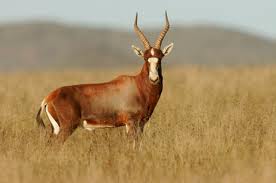
Numbers: High.
Weight = 60 - 82kg; 132 - 180 lb.
Shoulder height = 95 cm; 38 in.
Record Horn Length = SCI: 19 and seven eights in; Rowland Ward: 20 in.
Females horns? Yes
Found in central South Africa, the highveld areas, and thus not abundant in the Northern Province, KwaZulu-Natal and the Western Cape, but everywhere else it’s fairly common, especially in the Free State.
Three of the medium to bigger antelopes in South Africa is indigenously found in this country alone: the blesbok, the bontebok and the black wildebeest. “Blesbok” original Afrikaans meaning
is “glowing buck”, derived from the white face which strongly contrasts to the dark brown and black of the rest of the body. Today, the northern bushveld is home to many blesboks, as is the rest of the
country, but at first the blesbok would mostly be found in die grasslands of the highveld. The blesbok doesn’t insist on shelter or trees in his habitat.They are harsh on any misbehaviour
of their territorial boundaries and will, especially if it’s mating time, be more than willing to give challenge to opponents or to become a upright flanter of the nearby females. This includes stamping
his feet and snorting to the males with his head held high and then pointing his horns backward again and pulling his tail upward towards the females. They does sometimes – even if only another one has
come too close - kill each other in a fight to the end if a challenger persist.
Blue Duiker
(Latin = Philantomba monticola, Afrikaans = Blouduiker, German = Blauducker)
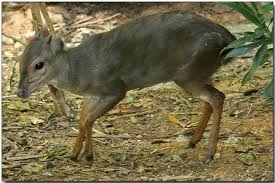
Numbers: Low.
Weight = 4 - 5 kg; 9 - 11 lb.
Shoulder height = 30 cm; 12 in.
Record Horn Length = SCI: 2 and four eights in; Rowland Ward: 4 and one eight in.
Females horns? Yes
The blue duiker are found only along the south coast of Kwazulu-Natal, right down to the north coastal area of the Eastern Cape, down with the garden route all along the coast into the Western Cape Province.
This tiny little antelope takes the prize for being the smallest antelope in South Africa. With front feet looking almost too short for those at the back, the big head and big eyes,
it’s eyesight and especially it’s nose serves as the only defense in the big and dangerous bush. Small wonder that the blue duiker is extra careful and nervously shy before it moves out in open spaces.
The blue duiker is a mix of dark brown and grey in colour, and when seen from behind, gives a blue shine effect which has earn him his name. It gives a moisture with a disctinct scent from glands in his
face and hooves which presumeably each having its own function in territorial and mating instincts. The blue duiker’s nerve is tested almost all day long, but, although its tiny little tail will be wagging,
he have survived in spite of his incredibly tiny measurements. Numbers of the blue duiker aren’t abundantly, however.
Blue Wildebeest
(Latin = Connochaetus taurinus, Afrikaans = Blouwildebees, German = Streifengnu/Weissbartgnu)
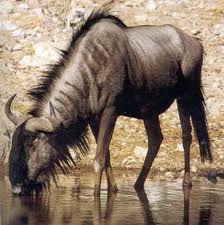
Numbers: High.
Weight = 180 - 270 kg; 396 - 594 lb.
Shoulder height = 135 - 150 cm; 54 - 60 in.
Record Horn Length = SCI: - in; Rowland Ward: 33 and seven eights in.
Females horns? Yes
Found in warmer areas, such as the northern parts of the Northern Province and Mpumalanga, especially in the Limpopo valley and in the whole of the Lowveld, as well as in all the Kalahari-areas of the
North Cape, extending almost into the Free State, and in a patch of the far north-eastern midland in KwaZulu-Natal.
This animal is often used as a symbol of the “out of Africa” experience, especially when the total strangeness, open spaces and wilder migrational animal behaviour is portrait.
South Africa don’t have as many wildebeests migrating as is sometimes seen in a few African states, but still numbers an abundance of blue wildebeests to be enjoyed in a enviable variety of scenic African
settings. They love to move in search of water and better savanna graze. Particularly the calves are falling prey to a vast variety of carnivores, because they share the same geographical surroundings as
the most vicious of animal-eaters. So, with the goodness of the early rainy season (coming from late September/October), the springtime and the newborn fawns, also comes some of the most devastating
fighting seen in the bush : a mother, fighting of hyenas, wild dogs or even the great cats in defense of her little one, sometimes sacrificing herself in the brawl. Her back secured in a thorn bush, her
knees dropped to the ground, her calve between the legs, she will snortingly face her ordeal. But often, she’s given a opening and, falling for the trick, she’ll realize too late that the calve can’t
outdistance the enemy and the day would belong to the carnivores. The bulls can be even more fierce, and when wounded, no hunter or lion can be off guard for once tiny moment, for he’s able to end a party
by his typical snorting, charging, and, sometimes, goring sweep, which will leave any hospital way too far off.
Bontebok
(Latin = Damaliscus dorcas dorcas, Afrikaans = Bontebok, German = Buntbock)
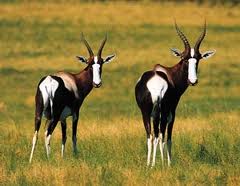
Numbers: Low.
Weight = 50 - 64 kg; 110 - 141 lb.
Shoulder height = 90 cm; 36 in.
Record Horn Length = SCI: 17 and five eights in; Rowland Ward: 16 and three quarters in.
Females horns? Yes
Found only in a southern part of the Western Cape
This is a downright beautiful antilope with his very rich purple-black and brown skin contrasting sharply with the cleanest of white feet, rump, tailbase and face. This once almost extinct
antelope of South Africa is now somewhat safer in numbers, although still not found in abundance. It is of much the same family tree as the blesbok (and could interbreed successfully with it,
although prohibited by law). Why the Bontebok had choose to “isolate itself” from the Blesbok (many, many centuries earlier) and reside in the Western Cape only, is an unanswered question, but the resemblance
with the Blesbok is obvious. And yet, the Bontebok has it’s own distinct identity and is smaller than the Blesbok.
Brown Hyaena
(Latin = Hyaena brunnea, Afrikaans = Strandjut, German = Schabracken Hyäne)
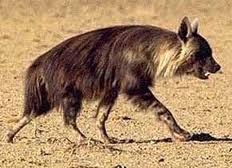
Numbers = Fairly high.
Weight = 42 - 47kg; 92 - 103 lb.
Shoulder height = 65 – 88 cm; 26 – 35 in.
Pregnancy time = 90 days
Pup quantity = Up to 4
Found in a vast area of the central and northern parts of the country. This includes the whole of the Free State, the Kalahari, the whole of the North West province, Northern Province,
Gauteng and Mpumalanga, but excludes the Kruger National Park, Swaziland and most of Lesotho. Is is also found in a small part of the North Cape’s most upper north western coastline.
The brown hyena isn’t a true hunter. It isn’t fast and may be called clumsy, and eats the leftovers of dead animals or fish, or searches for ostrich or other bigger bird’s eggs. Those
living near the sea will search for a dead whale or shark along the shore. It’s sense of smell is well developed and it will cover many a mile in search of a carcass which they “know by nose” to be out there.
It is a wary animal and will most likely not be seen in daylight. It leaves behind two sizes of a doglike spoor. This animal is always in search of a carcass and has the teeth and jaws to roundup a carcass of
the biggest game, swallowing crunches of bones that would be fatal to other animals.
Burchell’s Zebra
(Latin = Equus burchelli, Afrikaans = Bontsebra, German = Steppenzebra)
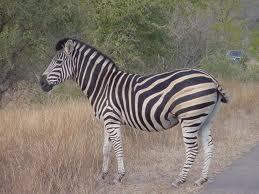
Numbers = Very high.
Weight = 320 kg; 704 lb.
Shoulder height = 136 cm; 54 in.
Pregnancy time = 375 days
Calf quantity = 1
Found all along the northern and eastern borderlines of the Northern Province, Mpumalanga and KwaZulu-Natal, with the inclusion of east Swaziland.
In spite of efforts to re-bred the extinct Quagga out of the remaining two species of Zebra/Quagga, only the Buchell’s zebra and the Cape mountain zebra survived the reckless
slaughtering of the South African wildlife between 1820 and 1926, which saw both the Blue buck and the real Quagga disappear in extinction. The burchell’s zebra, however, have survived in great
numbers. This animal loves the open plains, the grasslands (savanna) and the warmer climate of the northern provinces. It lives for about 22 years. The zebra isn’t an exclusive-living animal: it easily
shares it’s grazing with the blue wildebeest and other antelopes. The zebra, due to its high rating on a lion’s menu, has learned to be very wary. In any dual between two males, or in any survival battle,
the zebra can stand its ground fairly well with it’s hammering hooves and strong teeth. The zebra may live in herds of hundreds, even thousands of wonderful contrasting black and white shaded “mule-like”
figures. They have one of the most distinctly screams of the African wildlife scene, heard especially if danger struck one of the herd.
Bushbuck
(Latin = Tragelaphus scriptus, Afrikaans = Bosbok, German = Schirrantilope)
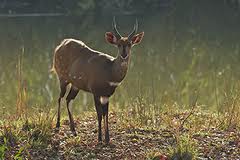
Numbers = High.
Weight = 24 - 54 kg; 53 - 119 lb.
Shoulder height = 80 cm; 32 in.
Record Horn Length = SCI: 19 in; Rowland Ward: 18 and a half in.
Females horns? No
Found all along the northern borders of North West Province, and abundantly in the warmer northern area (Bushveld) of the Northern Province, as well as in the whole Lowveld area of Mpumalanga,
across East Swaziland and in all the coastal areas of KwaZulu-Natal as well as the Eastern Cape Province’s coast, up to the Eastern coastal area of the Western Cape.
The Bushbuck may be a smaller antelope, but because of a ram’s aggressive temperament when wounded, have earned the respect of many a hunter. It is a bit shy, always secretive and often missed
by an tourist’s because it keeps in the shady mountain bushes or riverbeds where it’s black, red-brown and white colours makes it difficult to pinpoint the animal. Be alert when you are in the same
surroundings of a wounded ram, because it will attack furiously, and can cause much harm with its strong horns. The bushbuck >will, when it senses danger, sometimes bark with short, repeated
intervals. It is most often spotted in the cooler part of the day (or in overcast days), when it will wander outside its hiding places. The bushbuck will not hesitate to plounge into the water to swim to
safety, if nessasary, but it’s best defense is to stand dead still. It may then, if the hunter/tourist comes too close, suddenly accelerate with great speed out of its hiding place, causing the unaware to
skip a heartbeat!
Bushpig
(Latin = Potamochoerus porcus, Afrikaans = Bosvark, German = Flussschwein)
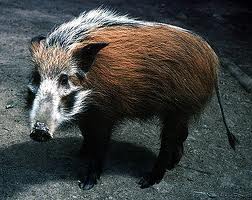
Numbers = Fairly high.
Weight = 46 - 82 kg; 101 - 180 lb.
Length = 132 - 173 cm; 53 – 69 in.
African Record for lower tusks = 11 and seven eights
Found Found in the border regions of the west, north and eastern parts of the Northern Province and eastern parts of Mpumalanga, including the warmer Kruger National Park, as well as in almost the whole
of Swaziland, the whole of eastern KwaZulu-Natal, and in the eastern and coastal areas of the Eastern Cape.
This pig isn’t a mere target for hunters – not by any change! It is a animal that is seldom seen at daytimes, always wary and hidden in the thickest of bushes, thus avoiding most danger.
And when danger looms, it will try avoiding it by moving away if possible. But boy oh boy, if the heat is on, this seemingly harmless animal turns into one of the real beasts of the bush! It kills a pursuing
dog in no time and may do the same to its owner. Its lower tusks holds the same serious danger to anybody than does a dagger of 20 cm (9 inches). And when a bushpig decides to become the hunter,
even the leopard will hesitate and backs down in search of a easier prey (or moment) to have it his own way.I should be said, however, that leopards will easily kill a bushpig if it surprises the
pig. They usually eats plant material, but don’t say no to eggs, reptiles and insects that is available. They flock together in families of up to 20, with a dominant male as leader. Females yield about three to
six little pigs each year. Farmers don’t like them at all, because of their sloppy disruptive ways with any field of crop. They don’t look like it, but can move quickly and is good swimmers as
well!
Cape & Sharpe’s Grysbok
(Latin = Raphicerus melanotis; Raphicerus sharpei, Afrikaans = Kaapse Grysbok; Sharpe se Grysbok, German = Greisbock Kap & Greisbock Sharpes)
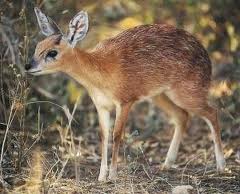
Numbers = Low.
Weight = 10 to 7,5 kg; 22 to 17 lb.
Shoulder height = 54 to 47 cm; 22 to 19 in.
Record Horn Length = SCI: 4 & 3 in; Rowland Ward: 4 and seven eights & 4 and one eight in.
Females horns = No
The Cape Grysbok is found in the Western Cape Province’s west coast and Garden Route into the Eastern Cape Province, all along the coast. Sharpe’s Grysbok is found in the most north eastern
area the Northern Province, in the Lowveld area of Mpumalanga, and in the northern areas of KwaZulu-Natal.
The two antelopes differ in geographical territory, in size and weight, in colour and in its hooves. And yet, they are virtually alike, share the same name (Grysbok) and are specified closely together
(as Raphicerus). On photo’s it is very difficult to spot the differences (and are therefore introduced together in this presentation). Only the Cape Grysbok feature an extra “under developed” hoove
above the fetlocks. The smaller Sharpe’s grysbok have a more defined redbrown colour on its back and neck than do the slightly more greyish Cape grysbok. At the foot of rocky hills where the bushes becomes
more dense, the grysbok can be spotted with it’s head down, alone (most of the time) and wary of intrution. When it is disturbed, it simply fly away, without a bound.
Cape Fox
(Latin = Vulpes chama, Afrikaans = Silwervos, German = Kapfuchs)
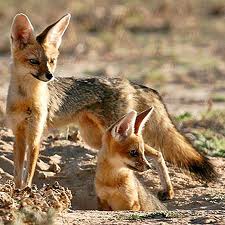
Numbers = High
Weight = 2,3 – 3,3 kg ; 5 - 7 lb.
Shoulder height = 35 cm; 14 in.
Pregnancy time = 51-52 days
Pup quantity = Up to 4
Found everywhere in South Africa’s central and western parts (from the north to the south, including the whole of the Free State), but nowhere in any of the eastern parts (thus absent from
the north to the south).
The silver coat of this little fox, especially in its winter thickness, is a prized piece of fur. Nonetheless, the Cape Fox have escaped endangerment thus far. This animal prefers nigh time
to wander about. During the day it mostly enjoys the comfort of its own burrow, dug by itself, although they might be seen in dense grass or hideouts as well. It knows how to capture a mouse or rat, while
it also feeds on various insects. It is disputed if this fellow holds any danger to newborn lambs.
Cape Mountain Zebra
(Latin = Equus zebra, Afrikaans = Kaapse bergsebra, German = Bergzebra)
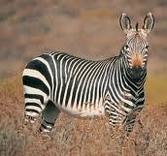
Numbers = Very low
Weight = 204 - 260 kg; 449 - 572 lb.
Shoulder height = 124 - 127 cm; 50 - 51 in.
Pregnancy time = 365 days.
Calf quantity = 1.
Found only in two mountainous places in the Western – and Eastern Cape.
The Cape Mountain Zebra very nearly went the same way as the Quagga. It was saved just in time by some farmers which helped to from the Mountain Zebra National Park. Today, while still
very endangered, their numbers have grown to a few hundred again. The mountain zebra have a “cleaner” look than do the the more abundant zebra in the north, due to the fact that it’s white stripes doesn’t
have an extra grey colour running in the white (as is the case with the burchell’s zebra). The mountain zebra is shorter, somewhat smaller but more solidly build, with a slightly different colour pattern
than the other zebra. This can best be seen at the legs, rump and under the belly, while it features a loose piece of neck skin as well. It will normally live for about 24 years.
Caracal
(Latin = Felis caracal, Afrikaans = Rooikat, German = Karakal)
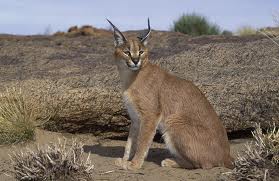
Numbers = Fairly high
Weight = 8 - 20 kg; 18 - 44 lb.
Shoulder height = 40 - 45 cm; 16 – 18 in.
Pregnancy time = 65 + days
Cub quantity = Up to 5
Found everywhere in South Africa, except in the most northern coastal area of the Atlantic Ocean (in the North Cape Province) and the most northern coastal area of the Indian Ocean
(in the KwaZulu-Natal Province). It is also not found in the eastern parts of KwaZulu-Natal.
The rooikat isn’t a big cat, but looks can be deceiving, for this little cat have been reported killing an full grown impala! Of course that isn’t his usual behaviour. But hunting dogs of twice the size of
the caracal have met their end when trying to take it on in a direct fight. His lightning claws are used to overpowered his prey. He shares with the leopard the art of ambush and stalk. His charactaristic ears,
with it’s long antenna-like patch of black hair growing from the back ear upwards, identifies him strongly as a very beautiful and unique creature. The caracal isn’t usually found in the same surroundings
as the bigger cats or hyena. In some areas the caracal is named in the same league as the jackal as a sheep and goat killing pestilence, but it is pretty satisfied with a diet of monkeys, large birds,
snakes or, naturally, defenceless fawns of antelopes or young baboons. It sometimes change a diet of fauna for a more floral one like wild fruit.
Chacma Baboon
(Latin = Papio Ursinus, Afrikaans = Kaapse bobbejaan, German = Tschakma-Pavian)
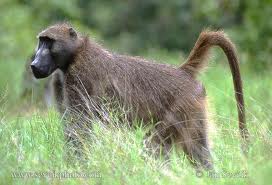
Numbers = Very high.
Weight = 14 - 44 kg; 31 - 97 lb.
Length = 107 – 157 cm; 43 -63 in.
Pregnancy time = 180 days
Young one’s quantity = 1, sometimes 2
Found all over South Africa, except in the Great Karoo and in the most northern coastal area of the North Cape.
This ones foot/hand combination reminds the most of the homo sapiens. Another similarity, is the fact that its numbers isn’t endangered at all! The ape most commonly found in South Africa is the vervet monkey,
but the baboon is the largest of them all. Compared to its size, it features one of the largest and most dangerous fangs. Baboons have such close knit social bonds, that they will easily team up to fend of
the dangers of a cheetah, python, leopard or, as in some instances recorded, even man! Sometimes, a leopard kills a baboon, is driven from the carcass and only later, after the baboons have left, dare to step
in for the remains. A true omnivore, but still, it like to spend its time by overturning stones in their search for some soppy insect or spider. They will even kill small animals when hungry, and is known to
be killing almost in the fashion of a pack of wild dogs. In the mating season, the female’s bottom swells heavily, an indication that ovulation is about to happen. A female baboon is one of nature’s
best mothers, with the fathers not far behind in model parenting!
Cheetah
(Latin = Acinonyx jubatus, Afrikaans = Jagluiperd, German = Gepard)
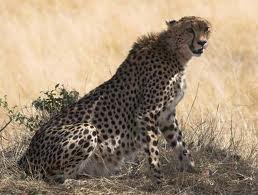
Numbers = Low
Weight = 36 - 60 kg; 79 - 132 lb.
Shoulder height = 80 cm; 32 in.
Pregnancy time = 90 days +
Cub quantity = Up to 6
Skull Measurements = SCI: -in; Rowland Ward: 12 and a half in.
Found only in the warmest areas, such as the bushveld (north western and northern parts) of the Northern Province and in Mpumalanga, especially in the Limpopo valley and in the
whole of the Lowveld, as well as in the upper Kalahari-areas of the North Cape.
This one’s 0 – 100 km/h time will shame those Ferrari’s, Porches and Lamborgini’s. Being the fastest animal on the planet, it has done it’s share to ensure that the mighty cat family is
unchallenged as the most awesome species sharing the same turf as us humans. The cheetah is a very calculated hunter: over an vast area of plain savanna filled with grazing antelope, it will
pierce from behind a dense cover of long grass or from a welcome bush in between. Once it has selected it’s victim, it doesn’t have space for second thoughts about easier prey : it seems as if the cheetah
have focal lenses fixed at a narrow angle on the poor antelope it’s heading for. It will take a calculated charge, changing into longer and longer strides toward it’s prey, until the prey is
fleeing in a somewhat isolating direction. Then, with a burst of power flowing from the very long back feet, the cheetah will “gear back” and accelerate with a bang to which no other creature
can compare, clearing an astonishing amount of meters with each stride, catching the nippiest antelope within seconds. With unbelievable acrobatics (at that speeds!), the prey’s dodging is overridden in a
dustcloud where a very fast tightening move of the victim’s throat takes place. Then it simply waits until the body of the captured animal slowly becomes liveless at the powerful grip of the cheetah’s mouth.
Incredible as it may sound, but this gruesome wonder itself was born as a helpless, blind bundle of vulnerablility to whom even an eagle could pose a deadly threat. An most rare subspecies is distinguished
(some would say their numbers are too low to speak of a real subspecimen), namely the most beautiful king cheetah, that have a more striped coating than the familiar spots of the common cheetah.
Common/Grey Duiker
(Latin = Sylvicapra grimmia, Afrikaans = Gewone duiker, German = Kronenducker)
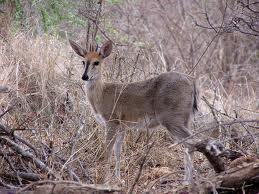
Numbers = High.
Weight = 15 - 26 kg; 33 - 57 lb.
Shoulder height = 51 cm; 20 in.
Record Horn Length = SCI: 7 and one eight in; Rowland Ward: 6 and one eight in.
Females horns = No
The common duiker are found allover South Africa.
The common duiker has survived the onslaught of all its enemies by being the most wide awake little antelope of them all. Their colour may vary from light grey to a much lighter combination
of yellow and redbrown. It so much prefers leaves (and wild fruits) to grass, that it will not easily settle if a fruit is just out of reach, even if it have to stand on it’s backfeet for a
moment. If times are rough, it will also eat what is not flora (such small birds) to survive. What may happen in some instances (as in other antelope species where the female don’t usually have horns), is
that the female may develop smaller and weaker horns, although this isn’t seen much. A small triangle of black hair between the horns have been mistaken at times as a third little horn. When the duiker
takes flight, it will dodge and side-step, combined with bounces in the air with erected legs, very quick to put some cover between itself and the danger it is sensing.
Eland
(Latin = Taurotragus oryx , Afrikaans = Eland, German = Elenantilope)
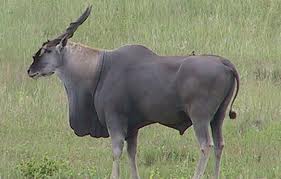
Numbers = Fairly high
Weight = 460 – 700 kg; 1012- 1540 lb
Shoulder height = 150 - 170 cm; 60 - 68 in.
Record Horn Length = SCI: 43 and six eighths in; Rowland Ward: 41 and five eights in.
Females horns = Yes
Found commonly in the Kalahari dessert (Northern parts of the North Cape) going down even to the south east Free State, as well as in a much smaller, distinct part of KwaZulu-Natal (the Underberg area at the
foot of the majestic Drakenberg mountains), and also in the Kruger National Park in Mpumalanga and in the neighbourings parts of the Northern Province.
The Eland was likened to an “ox-of-the-wild” many a time, and is domesticated on a few South African farms for its high quality milk and meat. And yet, never was it’s wild nature really shed, nor it’s
domestication complete. The Eland is a massive antelope, the largest of them all. It is one of the antelopes that isn’t by nature full of fury and fight. Still, the eland can move with lightning speed and can
jump with surprising ease up to eight feet high. It is usually very alert and will move quickly when sensing danger. Another defensive measure often used, is to change the direction of flight out of the blue,
and, while accelerating rapidly, thus securing their safety. The eland is able to go a long way without turning to the waterhole, for it can loosen water-rich and young plants with its thick horns; plants on
which they like to treat themselves.
Gemsbok/Oryx
(Latin = Oryx gazella , Afrikaans = Gemsbok, German = Südafrikanischer Spiessbock)
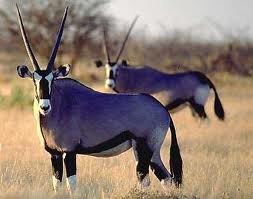
Numbers = Fairly high
Weight = 180 - 240 kg; 396 - 528 lb
Shoulder height = 120 cm; 48 in.
Record Horn Length = SCI: 47 and six eighths in; Rowland Ward: 48 and three eights in.
Females horns = Yes, longer than the male’s horns.
Found commonly in the Kalahari dessert (Northern parts of the North Cape), as well as in a much smaller, distinct part of the Northern Province (Ellisras to Alldays districts).
These animals have a incredible capacity to survive in desert conditions. They fill the Kalahari as if they were meant to be the great Artist’s desert paintings in a landscape where few other antelopes would
dare to tred. By wonderful design, their blood vessels ensure that the gemsbok have the capacity to cool its blood when passing its nose, from which it enters the brain. They thus flourish in an scorching
African environment where other animals would definitely be dead in a day. It uses its hooves for digging, finding water or water-bearing roots underground. The well known picture of some gemsbok wandering
on the top of a dune with heat waves blurring the scenes in between, add some spice to a “harsh” part of the South African landscape. The gemsbok is able to defend itself galliantly with those sharp horns.
Many a tale is told about the gemsbok, deflecting dangerous objects with those horns or using it as a lance in combat.
Giraffe
(Latin = Giraffa camelopardalis, Afrikaans = Kameelperd, German = Giraffe)
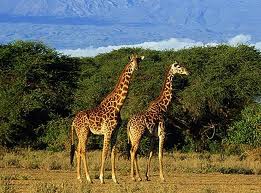
Numbers = Very high
Weight = 703 - 1395 kg; 1547 - 3069 lb.
Shoulder height = 272 - 347 cm; 109 - 139 in.
Pregnancy time = 457 days
Calf quantity = 1 or sometimes, 2
Found along the warmer Bushveld and Lowveld areas, especially the northern and eastern borderlines of the Northern Province and Mpumalanga.
This giant reaches almost 6 meters (almost 20 feet) in hight when fully grown. To challenge this animal in length, one need to go back to the Dinosaurus of old. It is said to make some
sound, but few people have heard this, because this animal prefers silence. Drinking water seems to be one of the most difficult endeavours for this fellow: he has to spread his legs wide apart and
bend his head way down. This naturally makes him a easy target for a lion. Small wonder, then, that the giraffe is most wary at the waterhole. It is a time-consuming effort. And when it does drink,
it will shallow nearly 50 liters of water. The lion loves giraffe meat, both for the meat itself, and also because it means two lazy weeks without the necessity of any hunting! However, some giraffes
have succeeded in killing a lion with its awesome hindleg’s kicking power. It can injure an enemy with the forelegs as well, while it also uses it’s head and neck as part of it’s arsenal in fighting
with other bulls. It’s running action probably comes the closest to reflect a “slow motion” scene, for with it’s heavy, high body, it shifts it’s two legs of the same side together until it reaches
galloping speeds. It can do about 50 km/h in a sprint, and it have a lot of stamina to sustain its run. It’s beautiful eyes is very effective as well. It’s calves can weigh up to 60 kg (132 lb).
Grey Rhebok
(Latin = Pelea capreolus, Afrikaans = Vaalribbok, German = Rehbock)
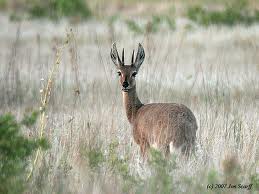
Numbers = Fairly High
Weight = 18 - 25 kg; 40 - 55 lb
Shoulder height = 75 cm; 30 in.
Record Horn Length = SCI: 11 in; Rowland Ward: 11 and a half in.
Females horns = No
Found especially in the Western Cape (except in some parts of the west coast), in the central and southern parts of the Northern Province, Gauteng and Mpumalanga (the Highveld), as well as in the western
part of Swaziland, the mountainous west part of KwaZulu-Natal, the whole of Lesotho, including north east, east and south Free State and everywhere in the Eastern Cape.
As the Afrikaans names indicate, the Grey rhebok closely resembles the Mountain reedbuck and is often confused with it. This happens all the more because both enjoys mountainous areas, although the Grey
rhebok prefers higher altitudes than does the Mountain reedbuck. The Grey rhebok easily gets nervous if intrusion takes place and will react aggressively, even if it means attacking and killing other
antelopes, such as the mountain reedbuck (or goats, even sheep). If it is approached, it will bounds off to a place less reachable by intruders, usually somewhere up higher. The Grey rhebok is slender,
with a sleek neck and remarkably long, thin ears. It has thinner and straighter horns than does the Mountain reedbuck. In the mating play, the rams will utter a deep, bass sound to try to influence the
spell. It is a delight to see this animals jump to safety in steep territory.
Hippopotamus
(Latin = Hippopotamus amphibius, Afrikaans = Seekoei, German = Nilpferd)
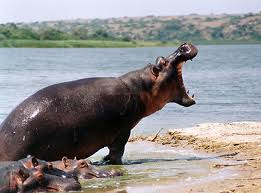
Numbers = Fairly high.
Weight = 1500 – 2005 kg; 3300 - 4411lb.
Shoulder height = 150cm ; 60 in.
Pregnancy time = 330 - 346 days.
Calf quantity = 1
Found along the warmer Bushveld and Lowveld river-areas, especially the northern and eastern borderlines of the Northern Province and Mpumalanga, as well as in a large part of the
northeastern KwaZulu-Natal area.
With it’s lower tusks reaching well above 60 inches (150cm), this animal is well underestimated as a dangerous brute. Some even say that it is the animal in Africa that kills the most people.
It usually happens if someone is using his way through the bush when it returns to the safety of the waterhole. It is still disputed if the white rhino really weighs more than this enormous mammal, probably
because both species are fairly difficult to encounter, let alone weigh! The hippo can “submarine” for more than six minutes, but gives away it’s presence easily with a typical misty spray when it returns
to the surface for a breath of fresh air. It can cover a very long distance by night and eats massive quantities of grass (or farmers weed!) each night. This have caused many farmers to shoot these creatures,
thus cancelling its presence in most of the South African rivers. In daytime, a hippo won’t wander far from the waterholes at all. In rivers, some small boats and canoes have been flipped over by an hippo on his
way to a breath of air, or when there are small hippos around. A running hippo is said to reach up to 30 kilometers/h. Extreme and fierce fighting occurs between bulls and they injure one another very heavily.
A big hippopotamus won’t fear many animals, except, in very rare circumstances, the lion. But smaller hippos may fall prey to the lions and crocodiles.
Impala
(Latin = Aepyceros melampus, Afrikaans = Rooibok, German = Impala)
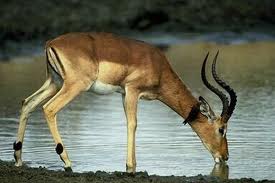
Numbers = Abundant
Weight = 39 - 80 kg; 86 - 176 lb
Shoulder height = 90 cm; 36 in.
Record Horn Length = SCI: 27 and three eights in; Rowland Ward: 31 and seven eights in.
Females horns = No
Found abundantly in the warmer northern area (Bushveld) of the Northern Province, just as in the whole Lowveld area of Mpumalanga, across East Swaziland and in the northern areas of
KwaZulu-Natal.
Today, the impala may be heralded as the most abundant antelope in South Afrca. It is also one of the bigger medium-size antelopes and therefore one of the most sought after by hunters.
This is all the more true, while the Impala ram features a pair of the most beautiful horns and it is thus a wanted trophy for many hunters. But eco-tourists and photographers are just as fond of the
Impala as a very special antelope of the South African bush: the incredible leaping abilities of the impala, the well defined shades of the white tummy, light brown and a very red-brown upper parts of the
impala’s body. When disturbed, a flock of impalas makes for the most dazzling circus-like gymkana of all antelopes, jumping up to three metres high, over bushes, or hurdles in only flashes of seconds,
incredibly fast, and in all directions. The impala naturally falls prey to many of the bigger carnivors, and is always on the alert at an unwelcome sound or smell. In early winter, during the mating season
in the South African bushes, fierce fighting occurs between the rams. Because not all males are allowed near the female flock, fighting determines if the impala is the mating male or destined to be part of a
herd of rams only. The impala can be noisy when fighting. When it senses direct danger, a loud snorting sound is heard. It is frustrating to a hunter/photographer, because mostly the impala will notice you
long before the shot/photo is taken. The impala prefers to dwell in a combination of grassland and bushes and will keep in a fairly small, familiar habitat.
Klipspringer
>(Latin = Oreotragus oreotragus , Afrikaans = Klipspringer, German = Klipspringer)
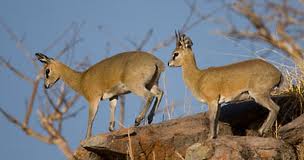
Numbers = Fairly high
Weight = 9 - 16 kg; 29 - 35 lb
Shoulder height = 60 cm ; 24 in.
Record Horn Length = SCI: 5 and seven eights in; Rowland Ward: 6 and a quater in.
Females horns = No
Found in a part of the western midland of the Northern Cape, the West Coast and the Garden Route area of Western and Eastern Cape, as well as all along the Maluti and Drakensberg areas of
Lesotho, Natal, Swaziland, the Escarpment and Lowveld areas of Mpumalanga and all the warmer areas (the north part) of the Northern and North West Province.
This little fellow is the dancer of the rocks, jumping up and down steep slopes of dangerous mountain rock as if it is a sprinters lane. Their hoves was created in a cup-like manner and,
depending on the rocks they climb, they vary their “grip-angle” and weight distribution to secure maximum tred each step of their slippery climbs. Even a fall just isn’t the same to them as to most other
creatures: they have a extra thick coat which can, to some degree, break their fall in case of miscalculation. This most surely is also a welcome saveguarding tool when a dangerous leopard, eagle or
rooikat ends up with mouth full of floppy grey hair instead of the real thing. They does give themselves to be seen sometimes : standing as if in a fresco high up in the safety of the rocky
terrain nody else can handle just the way they do, changing the skyline with the silhoutte of their proud little figures. It’s save to say that they aren’t much interested in another environment than the
hills and rocks they like to hop. They often are seen in pairs, sometimes up to three or four, and, when in danger, warn each other with a whistle-like snort.
Kudu (Greater)
(Latin = Tragelaphus strepsiceros , Afrikaans = Koedoe, German = Kudu Grosser)
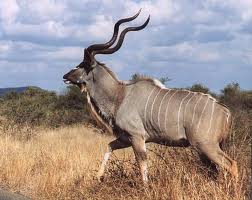
Numbers = High
Weight = 150 -300 kg; 330 - 660 lb
Shoulder height = 130 cm; 52 in.
Record Horn Length = SCI: 64 and six eighths in; Rowland Ward: 69 and a quarter in.
Females horns = No
Found all along the northern border of South Africa, from the most north-eastern tip of the Northern Cape, and abundantly in the warmer northern area (Bushveld) of the Northern Province, as
well as in the whole Lowveld area of Mpumalanga, across Swaziland and in the northern areas of KwaZulu-Natal as well. Found also in the north-eastern North Cape near Kimberley, and again in a vast area of
the Eastern Cape Province’s midlands.
Many a safari was planned in search for this exceptional hunter’s experience. The Kudu is undoubtedly, of all the big antelope, the one that is hunted the most in South Africa.
It is a wonderful “artist-of-the-bush”. It prevers the very dense bush and enjoys the leaves and fruits of the Bushveld trees. The kudu’s big ears are fine-tuned to hear the faintest unfamiliar sound. It isn’t
easy to surprise the Kudu in his own habitat, making a hunt all the more “exciting and fair”. The kudu can sense danger easily : when he’s under no threat, he will be standing as if he allows the spectator
a glance at his grandieur, yet, when you try to outsmart him as a hunter, he will “bark” out loud, sprint right through the thickest bush, tilting his head backward for the branches to slide past his long horns,
and be out of reach again.The young kudu will be brownish-grey, while the older kudu turns more grey and, especially the grand old bulls, later becomes a grey-blue royalty of the bush with massive curled, wide
spiraling horns – a real sought after elite trophy! Fierce fighting between males have, more than once, caused their long horns to interlock, resulting in a slow and painful death for both.
Leopard
(Latin = Pantera pardus, Afrikaans = Luiperd, German = Leopard)
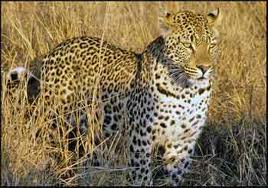
Numbers = Fairly high.
Weight = 30 - 71 kg; 66 - 156 lb.
Shoulder height 70 - 80 cm; 28 - 32 in.
Pregnancy time = 100 days.
Cub quantity: Up to 6
Skull Measurements = SCI: 14 in. (min score) ; Rowland Ward: 15 and a half in.
Found all over the Northern Province, North West Province and in Mpumalanga, except in the southern parts of the last two provinces mentioned. Also seen in the north of Swaziland,
the north eastern coastal, the North Cape Kalahari and west coast, as well as all the coastal areas of the Western and Eastern Cape, except for some areas in the far north east.
One of the much praised big five, this cat may be more than you’ve expected to encounter. The Leopard is everything you want it to be, and much more : being a animal of the night, it sometimes
surprises the tourist by showing his very strong body in broad daylight. This muscular beast is one of the animals able to move a weight which exceeds it’s own bodyweight by far – and then takes it as if it’s
nothing high up in a giant tree of the bushveld. It is a animal that have learned to survive where other became extinct in a vast area of the South African wildernis. In spite of it’s beautiful and brilliant
camouflaging coat, which have made him a prized trophy, the leopard’s numbers is still fairly high. It’s a privilege to be able to take a good photograph or shot at this creature, because of his stealthy and
superlative phantom ways. Once wounded, the leopard turns into the single most dangerous and unpredictable beast that anyone in the wild can encounter. It have, more than once, ambushed and killed very
well equipped hunters. It’s a job better left to the absolute professional hunter alone. Many of them, just because of their professionalism, would not take on such an enterprise! He may disturb a large
group of sleeping baboons at night for one of the most daring challenges : to make a midnight meal of one of them, knowing that they have the tendency to protect one another. This most incredible cat means
power, power, power!
Lion
(Latin = Panthera leo, Afrikaans = Leeu, German = Löwe)
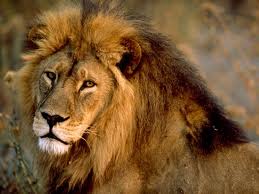
Numbers = Fairly high.
Weight = 238 kg ; 524 lb.
Shoulder height = 125 cm ; 50 in.
Pregnancy time = 110 days.
Cub quantity = Up to 6
Skull Measurements = SCI: 22 in. (min score) ; Rowland Ward: 24 in.
Found in warmer areas, such as the north and north eastern parts of the Northern Province and Mpumalanga, especially in the Limpopo valley and in the whole of the Lowveld, as well as in the
most northern areas of the Kalahari-areas of the North Cape, and in a patch of the far north-eastern midland in KwaZulu-Natal.
The unchallenged king of them all, the great African Lion, is, to many tourists coming to South Africa, the highlight of their African safari. This brute’s roar will fill an evening around
the open campfire with shivering and fear, having people check the fence and help to change any subject back to the safari essentials. The most beautiful full-grown male is spectacular in any man’s language.
However, this fellow will keep his mighty energies to himself when the hunt is on, which takes place during the night : the lionesses take initiative for this terrible, and at the same time awesome, event
that takes place every few days in a pride’s feeding routine. When they’re off for the hunt, no animal in the jungle can sleep peacefully (lions are on record for killing small elephants!) If the kill
produces a giraffe, there’s no hunt for a fortnight ; if the catch is small, the lionesses may see their hard-earned meal being taken by the male. But when danger looms – for example a very large group
of hyenas confronting one or two females at a catch – the mere entrance of the male will make the hyenas scatter in all directions. And woe to the hyena who pressures his or her luck to far! A pride of
lions may consist of up to thirty animals, and this corporate nature of a pack of lions are best illustrated in their hunting tactics, moving in a well synchronized manner when preparing for their bloody
midnight meals. In all the world, only the tiger of Asia can be compared to the massive strength and awe of this royal creature.
Mountain Reedbuck
(Latin = Redunca fulvorufula , Afrikaans = Rooiribbok, German = Bergriedbock)
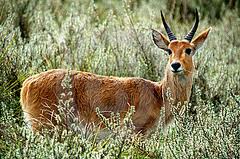
Numbers = Fairly High.
Weight = 22 - 38 kg ; 48 - 84 lb
Shoulder height = 75 cm; 30 in.
Record Horn Length = SCI: 9 and five eights in ; Rowland Ward: 11 and a half in.
Females horns = No
Found in the central and eastern parts of the Northern Province and Mpumalanga, especially the escarpment, avoiding the warmest parts, as well as in east Swaziland,
mountainous east Free State, the whole of Lesotho and KwaZulu-Natal, and in the eastern highlands of the Eastern Cape.
Although it is related to the bigger Reedbuck, it is much smaller and very specificly a wanderer of the rocky hills, small mountainous slopes and uneven mountainside where some shelter or
mountain bush can be found. The ridged horns ends in smooth, forward bended tips. They move around somewhat to secure both safe grazing in the slopes and having their time at the waterholes before dark.
The head of the herd will oppose potential competition, driving away his matured opponents with sounds of whistle and cry, if not with more force. They aren’t spotted too often in mid day and won’t hesitate
to move far off if disturbed, covering a climb that took man half a day in just a few shift seconds!
Nile Crocodile
(Latin = Crocodylus niloticus, Afrikaans = Nylkrokodil, German = - )
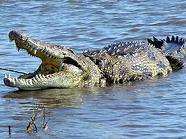
Numbers = Fairly high.
Weight = 1000 kg ; 2200lb.
Length = Up to 5,5 meter; 220 in.
Time from eggs laid to young ones = 90 days.
Young one’s quantity = 25 – 90 eggs (1 out of 50 survive!)
Found along the warmer Bushveld and Lowveld river-areas, especially the northern and eastern borderlines of the Northern Province and Mpumalanga, as well as in a large part of the
northeastern KwaZulu-Natal area.
Although a newborn crocodile only weighs about 90 grams, and measures only 25 – 30 cm (12 inches), feeding on insects, it may reach an enormous length, weight and age, and then even
feeds (although very rarely) on giraffe, buffalo and – yes – lion! Crocodiles are believed to reach up to 100 years of age! Of course, the crocodile won’t in general take on these above-mentioned
animals. Rather, a medium-sized antelope would normally serve as its prey every two to three weeks. The crocodile will almost certainly be seen near a river or riverbed, although they migrate on land
if a river runs dry. It is a myth that the crocodile prefers rotten meat above fresh meat. It always swallows its food above the surface. It will ambush an unsuspected animal while the latter is drinking
water. By drifting nearer almost without notice (on the eyes and sometimes the nose may be above the water) it will come very close to the prey. It can keep its nose under water for up to 15 minutes.
Then, like lightning, it will struck by grapping the nose or foot of the victim. It directly returns to the water, where the strong tail will keep the crocodile swimming while the poor victim won’t have
any defence left. But be aware: crocodiles do catch its prey sometimes at land as well! It can’t run far at high speeds, but is incredibly fast over a very short distance. It’s enemies is the hippo,
who will definitely defeat the crocodile. Elephants sometimes also kill a crocodile. Be on the alert for this brute with it’s cat-like yellow-green eyes and its deadly teeth : all 75 odd ones of them!
Nyala
(Latin = Tragelaphus angasii , Afrikaans = Nyala, German = Nyala)
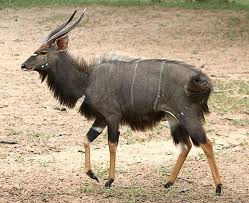
Numbers = Low to fair
Weight = 55 - 127 kg ; 121- 279 lb
Shoulder height = 97 - 127 cm ; 39 – 45 in.
Record Horn Length = SCI: 32 and three eighths in ; Rowland Ward: 30 and a quarter in.
Females horns = No
Found commonly only in the north-eastern borderareas of the Northern Province, as well as in the most northern parts of KwaZulu-Natal. In some Bushveld areas of the Northern
Province, it is at the moment being re-introduced by gamekeepers.
The most noteable and unique feature of this antelope, is the total difference between the male and female nyala. While the male is grey-black with faint white stripes and very light brown
legs in colour, much bigger, heavier and graced with a long pair of dangerous horns, the female is red-brown (almost chesnut) coloured with unmistakeably manifest white stripes, smaller, lighter in weight
and without horns. The female also doesn’t feature that sudden difference in colour between her upper and lower legs than does the male. The nyala is a secretive, shy and docile antelope. This doesn’t mean
that the bulls don’t have brutal fights with one another, although they sometimes settle the score simply by a male ritual which include a cocky circling of one another, arrogantly displaying themselves in
negociating aggression, until one of them backs down and thus granting the other his superiority. Of course, this often do lead to a fight, but it seems that the Nyala comes
closest to proves that it’s not only the fittest who have to survive. With the bushbuck, the Nyala are found in riverbeds, mountain forests or where the shadows in the bush allows for a dense hiding
area.
Orobi
(Latin = Ourebia ourebi , Afrikaans = Oorbietjie, German = Bleichböcken)
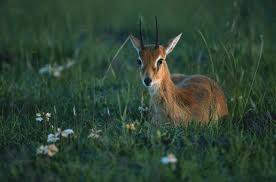
Numbers = Low
Weight = 10 - 17 kg ; 22 - 37 lb
Shoulder height = 59 cm ; 24 in.
Record Horn Length = SCI: 7 in ; Rowland Ward: 7 and a half in.
Females horns = No
Found in the central and eastern parts of Mpumalanga, north-western and southern KwaZulu-Natal, around the south-eastern parts of Lesotho, and in the most eastern parts (and in a small coastal area)
of the Eastern Cape Province.
The Oribi, just as the steenbok, prefers open country, but can handle highland area better than the steenbok. It has a fairly high white rump with a distinct black tail with a long neck (and is slingtly
larger than the steenbok). It feels comfortable when there’s patches of grass or bush nearby to hide in, or otherwise it will make a squatting sound. If danger lurks too close,
it will take off at a dazzling speed with an alarmed squeak. It will soon, however show itself by jumping in the air at high speed to improve it’s view. In combination to it’s habit of stopping
and looking back, hunters have often take advantage of this halt. This can be seen in their numbers today.
Red Duiker
(Latin = Cephalophus natalensis, Afrikaans = Rooi duiker, German = Rotducker)
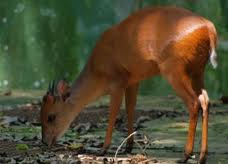
Numbers: Low
Weight = 11 - 14 kg ; 24 - 31 lb.
Shoulder height = 43 cm ; 17 in.
Record Horn Length = SCI: 4 in ; Rowland Ward: 4 and one eight in.
Females horns = Yes
The red duiker are found only along the southern escarpment and Lowveld area of east Mpumalanga, in a small patch of central (slightly north) Northern Province, but mostly in the north coast
area of KwaZulu-Natal.
The disctict red little antelope is not spotted often, for both in numbers and in boldness it won’t score high. Shaded in the colours of the sunset, the red duiker much prefers the thick bush
and mountain or forest areas and river-beds. Under the shades, it will find itself a way where others aren’t even aware of any moving space. Going solo for most of the year, it will in the mating season
temporily be seen in pairs. Then, aromatic body fluids (mostly from glands near the eyes or the nose) will play its part in the teaming up game. The red duiker lives in areas that are stuffed with wild
fruits, and makes ample use of this in its diet. The red duiker is smaller than the common duiker and very wary of intrusion. It takes a lot of seeking before this one will be found, and, long before the
cameras will click, only the echo of it’s sharp squeak will be noticed. For by then this one will already be much, much deeper in a dark tunnel of forest thickness.
Red Hartebeest
(Latin = Alcelaphus buselaphus, Afrikaans = Rooihartbees, German = Kaama)
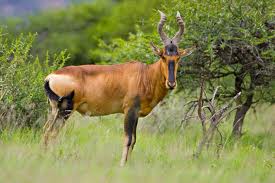
Numbers = Fairly high.
Weight = 105 - 182 kg ; 231 - 400 lb.
Shoulder height = 125 cm ; 50 in.
Record Horn Length = SCI: 27 and two eights in ; Rowland Ward: 29 and a half in.
Females horns = Yes
Found indigenously only in the North Cape Province in the Kalahari sand and grasslands (just touching the south western North West Province as well).
It should be obvious that the Red hartebeest doesn’t depend as much on water as other antelopes, for life in the Kalahari plains and dunes are harsh and extreme. They do have a feel for
water, though. Not only do they dig out watery roots and vegetation, they also wander in the open (mostly dry) floodplains and vleilands in search for moist, and when they sense that rain have come down
somewhere, even far away, they will migrate in their hundreds. When they found water (or when the rain comes down), they will be joyfully energized by it. Like the tsesebe, they are exceptional sprinters
and should be caught really of guard not to outrun the most other animals. The only time the red hartebeest needs shelter, is when it search a hiding place for its newborns. The calves does have the same
colour as the Kalahari sand, but this natural camouflage isn’t always enough to keep all the carnivores at bay. Although the females also have a pair of the double twisted horns, the males’ horns are heavier.
This big long-faced animal is extremely inquisitive and will, even at its own cost, first stare at a newcomer – though it might be danger lurking – before bewilderment takes over. Then, for a moment,
the herd will circle nervously before they decide on a direction of escape escape. Once on their way, their awesome speed is combined with a side-stepping and bouncing action which indeed
makes for difficult catching up.
Common Reedbuck
(Latin = Redunca arundinum , Afrikaans = Rietbok, German = Grossriedbock)
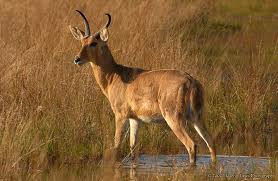
Numbers = Fairly Low.
Weight = 40 - 80 kg ; 88 - 176 lb
Shoulder height = 80 - 90 cm ; 32 – 36 in.
Record Horn Length = SCI: 17 and three eights in ; Rowland Ward: 18 and and three eights in.
Females horns = No
Found in the central and eastern parts of the Northern Province and Mpumalanga, including the warmer Kruger National Park, as well as in the whole of Swaziland, the mountainous tip of north east Free State,
mountainous tip of east Lesotho, the whole of KwaZulu-Natal, and in the eastern highlands and coastal areas of the northern Eastern Cape.
Much more at ease in the lower and especially wet areas, while still quite well equipped for the highlands, is the Reedbuck. The female will hide her newborns in a soft bed between the reeds
of a riverbed or vleiland with ample vegetation. She will confuse an intruder by secretly steering away from her fawn and even gliding into the water if the density of cover is failing her.
Sometimes a reedbuck simply seems to have “disappeared”, while in fact it is hiding between the reed or floating debris, with only the nostrils above the surface. They will more readily (and magnificently)
crack open the reeds in awesome speed, bounding out of danger while having a kick or two just in case a lion tries to pursue in this terrain where the reedbuck is much more at home.
Somewhat of an enigma is a low frequency sound which comes with every bound as it crashes through the reeds, but this dose enhance the beauty of this flight!
Roan
(Latin = Hippotragus eguinus , Afrikaans = Bastergemsbok, German = Pferdeantilope)
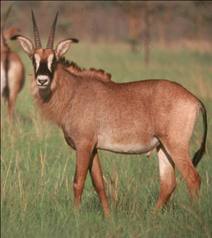
Numbers = Low.
Weight = 227 – 272 kg ; 500 – 600 lb
Shoulder height = 140 cm ; 56 in.
Record Horn Length = SCI: 31 and five eighths in ; Rowland Ward: 39 in.
Females horns = Yes
Found in the North-eastern parts of the Northern Province, especially the National Kruger Park, as well as in some distinct part of the North-West Province
This is close to the second largest antelope next to the eland, but it’s beaten by some of the biggest kudu. Very often, though, the “royal roan” is the heavier. They keep in small herds
and move over vast areas of tall grasslands or bushveld. It doesn’t bred most of it’s calves, because the red-brown calves are one of the more popular meals to the bigger cats, especially the lion.
Adult males and females do defend themselves. They can even be very dangerous when they lack an escape route. This animal shares the feature of backward-curling horns only with the sable antelope (it has,
however, also been the case with the extinct blue antelope). The roan is guilty of being a bit on the curious side, for it usually stops to look back after it has heard or smell the hunter and has run some
hundred yards through the bush. Of course, this presents the hunter with a grand chance for his trophy ambitions! Because of this “weakness”, the majestic roan isn’t found abundandly anywhere in the bush
anymore.
Sable Antelope
(Latin = Hippotragus niger , Afrikaans = Swartwitpens, German = Rappenantilope)
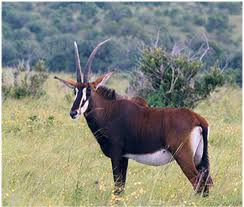
Numbers = Low.
Weight 180 – 230 kg ; 396 – 506 lb
Shoulder height = 135 cm ; 54 in.
Record Horn Length = SCI: 52 and a half in ; Rowland Ward: 60 and a threequarter in.
Females horns = Yes
Found in the warmest parts of the Northern Province, especially the Limpopo-valley, as well as in the Lowveld area of Mpumalanga.
This graceful animal was always been overpoured with the grandest of complimentary adjectives. If this antelope is seen in action, it is easy to understand why so much superlative language
has always been used to describe it. It is said to be the bravest of all antelopes, an animal who will, regardless of it’s enemy, put up a warrior-like fight to protect itself. Some call it the
king of the antelopes. Some simply say it the most noble, most graceful, most beautiful antelope you’ll ever find. Over the years, it is reported by more than one observer, even to have killed a lion!
When cornered, it stick to it’s sharped edged “guns” (horns) of up to 50 inches or more , lifts up it’s mane and fights to the gruesome end. The females are more brownish (and may even vary in distinct
shades of brown) with shorter horns, while the bulls are heavier, have longer horns and are found in a kingly black colour, which may also vary in shade in different regions. All sable antelopes have very
typical white skinned tummies and faces, with a black-coloured centre-stripe running from the forehead to the nose. It isn’t an animal that you’ll meet very often, and it isn’t even the biggest antelope of
them all, but it’s reputation doesn’t lack any greatness.
Serval
(Latin = Felis serval, Afrikaans = Tierboskat, German = Serval)
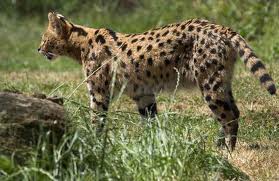
Numbers = Low.
Weight = 8 - 14 kg ; 18 –31 lb.
Shoulder height = 55- 60 cm ; 22 - 24 in.
Pregnancy time = 68 – 72 days
Cub quantity = Up to 3
Found all along the eastern parts of the country, especially in the eastern Northern Province, Mpumalanga and the north eastern and central KwaZulu-Natal. It isn’t found in waziland. It is also not found in
the south eastern parts of KwaZulu-Natal. It is found in the north eastern coastal area of the Eastern Province. But it’s not found in any central, southern or western part of South Africa.
The serval is a slender and sleek, beautiful cat. It is at the same time spotted, striped and barred, big eared and with a dark and light yellow skin. It is standing high on it’s feet for
it’s weight. The serval is a shy, very seldom spotted cat and it’s declining numbers are a worrying factor. He’s diet is somewhat strange, ranging from fish and insects, to birds and small mammals.
Side-striped Jackal
(Latin = Canis adustus, Afrikaans = Witkwas jakkals, German = Streifens Chakal)
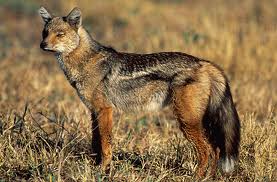
Numbers = Very low.
Weight = 7 - 12 kg ; 15 - 26 lb.
Shoulder height = 38 cm ; 15 in.
Pregnancy time = 60 – 70 days
Pup quantity = 4 - 7
Found only in the eastern Lowveld of Mpumaplanga, eastern Swaziland and the coastal regions of northeast Kwazulu-Natal.
This biggest of all the jackals is endangered because of it’s lack of wariness (although it may be very timid), it’s rather slowness and because of its skin and, especially, it’s beautiful tail.
Although rarely seen, it can interbreed with a domestic dog. It’s white tail tip is often the best identification clue. It surprises its prey by pouncing on it to make up for its lack of
printing speed. Small animals, birds or scavenging carcasses, for which it will risk being spotted by a would-be enemy, provides its main diet.
Spotted Hyaena
(Latin = Crocuta crocuta, Afrikaans = Gevlekte Hiëna, German = Gefleckte Hyäne)
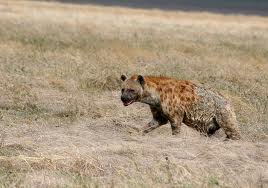
Numbers = Fairly high.
Weight = 49 - 80 kg ; 108 – 176 lb.
Shoulder height = 80m ; 32 in.
Pregnancy time = 110 days.
Pup quantity = Up to 4
Found in warmer areas, such as the north and north eastern parts of the Northern Province and Mpumalanga, especially in the Limpopo valley and in the whole of the Lowveld, as well as in the
most northern areas of the Kalahari-areas of the North Cape, and in a patch of the far north-eastern midland in KwaZulu-Natal, much the same territory of the hyena’s biggest enemy, the Lion.
This much underestimated animal was previously considered to be the ash-tray of the bush, sharing the cleaning up job with the jackals and vultures of the bush. By it’s shadowy and uneven profile, it’s
awkward gallop, it’s “cowardly” challenge-change-to-flight” habit (in case of a lion’s attention), it’s “hysterical laughter” and association with second hand
corpses, the spotted hyenas is portrait by many as the maniac of the African field. Only later did it came to light that the spotted hyenas hunt just as much, and often even more, as the
lions do. Lions will even wait for the hyenas to do the killing, after which they will move in and take the free meal by fear and force from the hyenas. The whining of hungry hyenas waiting unpatiently
for the irritated lions to finish their meal, is one of the most interesting settings a tourist can wish to encounter. As the lions are eating, the number of vultures, foxes and hyenas will grow, making
for one of those very tense and noisy situations where nerve and danger are stretched to the limit. Sometimes, by sheer power in numbers, the hyenas will challenge the lions for a portion of
the meal, hastily assembled by the hyenas gruesome jaws. It may even attack a lion from the back, where the dual between the hyena’s jaw and the lion’s paw usually, but not always, ends in favour of the
paw. Beware of this prowling creature, for when any prey, which may include sleeping people or wandering children, are without protection, the hyena might launch an unexpected attack.
Springbuck
(Latin = Antidorcas marsupialis , Afrikaans = Springbok, German = Springbock)
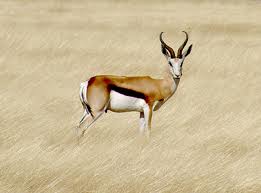
Numbers = High
Weight = 30 - 48 kg ; 66 - 106 lb
Shoulder height = 75 cm ; 30 in.
Record Horn Length = SCI: 18 and one eighth in ; Rowland Ward: 19 and three eights in.
Females horns = Yes
Found in the whole central and western midland of South Africa, the more dry countryside of the “wide open horizon”, even up to the west coast of the North Cape Province.
This beautiful antelope wasn’t chozen without reason to be the most well-known symbol of the South African sportsmen and –women. In the nineteenth century, this antelope roamed the plainlands of the
South African Karoo, Highveld and Kalahari sanddunes in their millions. Their massive migrations is still well documented : for many a traveller the most spectacular sight of his of her life (a sight which
could cover an area of up to forty miles!) Today, although their numbers have dropped enormously, it is still found abundandly. The abundance of white colour that the springbok feature together with the dark
– almost black – shading, mixed with the light brown skin, the pair of horns which together almost forms a heart shaped figure and the typical black stripe which connects the eyes to the nose, gives the
springbok a most definite identity in the family of antelopes. And yet, none of the features could compare when this buck was first named : this antelope can, both in play and in flight, perform such a
striking “gymnastic” jump, that it earned him the name as the “jumping buck”, the Springbok. From a standstill, or while in running, he suddenly takes of almost right into the air, hanging for a second in
mid-air as if in slow motion, before shooting forward again with lightning speed. It’s a typical South African gem to appreciate!
Steenbok
(Latin = Raphicerus campetris , Afrikaans = Steenbok, German = Steinantilope)
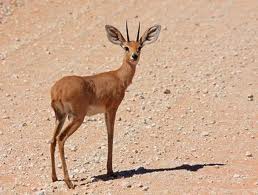
Numbers = High.
Weight = 9 - 14 kg ; 20 - 31 lb
Shoulder height = 52 cm ; 21 in.
Record Horn Length = SCI: 6 and two eights in ; Rowland Ward: 7 and a half in.
Females horns = No.
Found everywhere in South Africa, except in the coastal areas of KwaZulu-Natal.
The open fields for this little survivor, please. When almost all other antelope was forced into specified areas in the country by hunters, animal enemies and development, this fellow wasn’t
to be taken out with the others and sticked to its ground. In the Bushveld and Lowveld, the steenbok numbers takes second place only to the Rooibok. It takes shelter easily in a small bush or
long grass and isn’t found in mountainous or forest areas. Being a loner, it has helped to keep most of them out of danger. The steenbok male and female only meets in mating season. Then they choose their
solo wandering ways again. Although the steenbok is standing only half a meter high, it can outsprint most carnivores. All the steenbok thus uses when threatened, is to hide in the nearest cover, waiting
for danger to pass, and if it doesn’t, it will react with breathtaking speed.
Suni
(Latin = Neotragus moschatus , Afrikaans = Soenie, German = Moschuböcken)
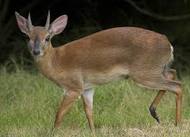
Numbers = Very low.
Weight = 4 - 6 kg ; 9 - 13 lb
Shoulder height = 35 cm ; 14 in.
Record Horn Length = SCI: 4 and five eights in ; Rowland Ward: 5 and a quater in.
Females horns = No
Found only at the northern tip of the Kruger National Park and the most northeastern and coastal areas of KwaZulu-Natal.
This very rare little antelope is, because of it’s low numbers, under extreme strict protection. It usually prevers a dense bush above the dryer fieldlands, but has the habit of sticking to
the same territory and bushways, with the result that it easily falls prey to anyone who knows it’s area. The suni’s enemies futher have the advantage of a very specific musk-like scent which is the result
of secretion that flows out of the glands under the eyes (and which is believe to be used to mark it’s terrotiry). The suni will stand motionless when it becomes aware of danger,
which does favour the enemy. However, when the Suni realize that the danger it drwing too close, it will take off in flight. The female is a bit heavier that the male (as in many of the very
small antelopes’ case).
Tsesebe
(Latin = Damaliscus lunatus, Afrikaans = Basterhartbees, German = Halbmondantilope)
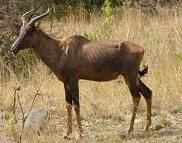
Numbers = Fairly Low.
Weight = 120 - 150 kg ; 264 - 330 lb.
Shoulder height = 120 cm ; 48 in.
Record Horn Length = SCI: 19 and four eights in ; Rowland Ward: 18 and a half in.
Females horns = Yes
Found only in the warmest northern parts of the Northern Province and Mpumalanga, especially in the Limpopo valley and in the Lowveld.
The tsesebe’s numbers was, a few years ago, reason for grave concern, but are today on the increase, mostly due to some resettlement in the Bushveld areas of the Northern Province. The
inquisitive tsesebe has – in the case of hunting - the weakness to take flight for a short distance if disturbed, only to stop and look back at the danger. This usually presents an ideal chance for the
hunter. It may be due to the fact that the tsesebe don’t have to fear that many animals could catch it from behind. This antelope competes with the cheetah for the prized honour of being the fastest mammal
in Africa and is maybe just outdone in the trick. The tsesebe keeps in groups which can sometimes number quite high. An open savanna field with a fair amount of trees will do just great for their stay, thank
you. The family group is led by a pride but dominating bull, which can go some length to intimidate any possible challenge from his pears. He’ll easily drop to his knees and work the soil in
front of him with his horns as an intimidating rite to his would-be opponents. Some people consider it to be simply an ugly antelope. It is, maybe, nowhere near to be seen if prizes were given for grandieur
and beauty. Yet, it is a beautiful part of the South African antelope variety with its muscular shades of black, redbrown and grey colours, wide “Viking” horns and long, black faces.
Warthog
(Latin = Phacochoerus aethiopicus, Afrikaans = Vlakvark, German = Warzenschwein)
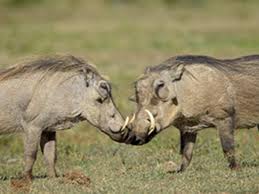
Numbers = Very high.
Weight = 4 - 104 kg (and more) ; 97 - 229 lb.
Shoulder height = 60 - 75 cm ; 24 - 28 in.
Pregnancy days = 167 – 175.
African Record for upper tusks = 24 in (Lower tusks average about 6 inches)
Found abundantly in the Bushveld, the warmest (northern) parts of the Northern Province, especially the Limpopo valley, as well as in the Lowveld areas of Mpumalanga, and in the north eastern part of
KwaZulu-Natal.
This is one of the daytime wanderers, often seen in the open savanna, preferably not too far from the waterholes. It feeds on grass, but also likes meat, fruits, or digging out plants for its watery roots.
It sometimes goes into a kneeling position to eat. It isn’t as hairy as the bushpig, but its colour may vary, depending upon which waterhole was the last to have a mudbath in. Very,
very typical, is the straight upright tail, as an antenna, when it is running. Maybe it serves as a checkpoint to the smaller ones if a sudden flight is necessary. They pose much the same danger to a hunter as
does the bushpig, although they might be somewhat more oblige to move away. They form family groups that sticks together, although older bears would be alone. They hear and smell good, but doesn’t see all that
sharp. They may easily hide in a antbear hole, but will move in in reverse, so that a pursuing dog will have a nightmare to escape its incredibly dangerous tusks. They can run very fast (some say at 55km/h).
Their usual enemies, like the lion, leopards, cheetahs and wild dogs all have some respect for its vicious and able power to defend himself.
Waterbuck
(Latin = Kobus ellipsiprymnus, Afrikaans = Waterbok - sometimes called “Kringgat”-, German = Ellipsenwasserbock)
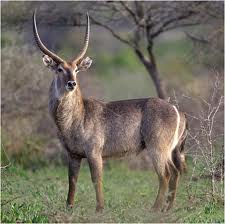
Numbers = Fairly low.
Weight = 204 - 270 kg ; 448 - 594 lb.
Shoulder height = 125 cm ; 50 in.
Record Horn Length = SCI: 36 and two eights in ; Rowland Ward: 39 and a quater in.
Females horns = No.
Found in the warmest (northern) parts of the Northern Province, especially the Limpopo valley, as well as in the Lowveld areas of Mpumalanga, as well as in a part of central to north east
KwaZulu-Natal.
The name of the buck is right on track, being a lover of the waterholes, riverbeds and vlei. And yet, the waterbuck isn’t afraid to wander far off from any water. It is sometimes found in
hills or steep climbs with no water nearby at all. This massive animal is a beautiful, graceful antelope, with a very distinct white circle around the back rump. An unpleasant smell (to man) accompanies the
waterbuck which stems froms glands in the animal’s skin. When a hunter hunt to use it’s meat, care has to be taken not to slice these glands. Although big, the waterbuck is good at camouflaging itself from
intruders. In case of a too close encounter, it will crash out of hiding and make one of the noisiest sprints of all the animals. It is comfortable in water and uses this sometimes as a last resort when pursued
by carnivores. Then it will fight viciously with it’s very sharp horns and forehead. It can be suprizingly robust and photographers and hunters should take some care not to corner the animal,
because it will not hesitate to attack a man or women, all the more when it is wounded.
White Rhinoceros
(Latin = Ceratotherium simum, Afrikaans =Witrenoster, German = Weisses nashorn)
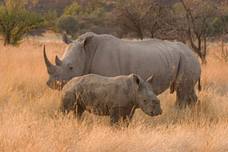
Numbers = Fairly low.
Weight = 1400 – 2300 kg ; 3080 - 5060 lb.
Shoulder height = 180 cm ; 72 in.
Pregnancy time = 480 days.
Calf quantity = 1.
Found in the Kruger National Park (and some surrounding parks), at game parks in the northeastern area of KwaZulu-Natal, at some game farms in the North West Province, in more and more game
farms in the Northern Province.
Much more relaxed than the black rhino, this “prehistoric” figure is, in own right, a massive animal. This square lipped rhino is, with the hippopotamus, next in line of size in the mammal
world after the elephant. Although it shares the bad eyesight and receptive hearing with the black rhino, it doesn’t share its bad temper. Tourists can dare to come a little closer to this one without
having as much to fear. Seeing this rhino run (usually, if not too much disturbed, in small circles), is a brilliant, almost “slow motion” feast for the eye. A rhino can consume up to 100 kg of grass a day.
It’s awkward horns can grow way over 60 inches, but this is also, in many instances,the sought-after item which illegal hunters try to obtain. This have caused the unplanned death of many rhinos.
After the shock of 1920 (there was only 20 of these creatures left in the country) its numbers today have recovered to the extend that it’s future seems to be well-guaranteed.
Wild dog
(Latin = Lycaon pictus, Afrikaans = Wildehond, German = Hyaenenhund)
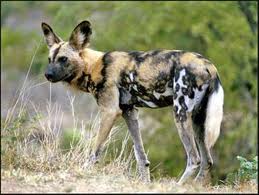
Numbers = Very low.
Weight = 26 – 28 kg ; 57 - 62 lb.
Shoulder height = 60 - 78 cm ; 24 - 31 in.
Pregnancy time = 69 – 73 days.
Pup quantity = 2 - 16.
Found only in the Kruger National Park and directly neighbouring Parks.
Like the wolf of Europe, this one is a pack-animal : they will live, hunt and breed in packs of up to forty animals. Known for its very gruesome hunting style of chasing and chasing and
chasing animals which, on a short sprint, would easily outstrip the wild dog, they take turns to do the direct chase, often tearing parts of the body out of the poor victim. In the end, the exhausted prey
would stop to defend itself. By sheer numbers they will attack from too many sides to defend. In this non-stop action of blood and dust, the wild dogs will tear apart a living animal! The wild dogs never
stays long in the same area and may chase an entire herd of wild animal out of its territory in a short period of time. They might even attack a human being, although a unfamiliar reaction from their prey
may prevent a tragedy. Their pups are raised by the whole pack, usually in good shelters like antbear holes where the pack will regurgitate to let the pups eat partially digested food. Both because of their
vicious influence on other animals, as well as their very characteristic odour, tracking of these packs of wild dogs have been very successful performed by many an old hunter, which explains in part their
low numbers. Other reasons for its endangered status is their vulnerability to sickness, and the strange behaviour of some females to kill other mother’s puppies.



